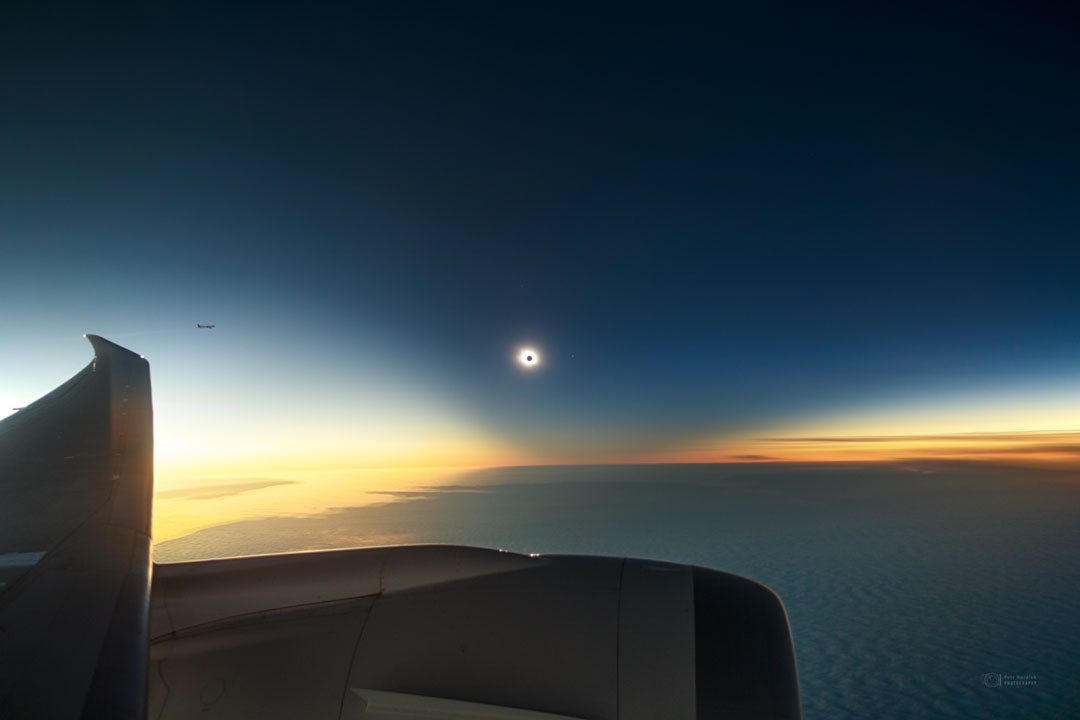05. December 2021
Tī 世界尻川尾 ê 日全食

探索宇宙1!逐工會揀一幅無仝款 ê 影像抑是相片,𤆬你熟似咱這个迷人 ê 宇宙,閣有專業天文學者2為你解說3。
- 原始文章:Total Solar Eclipse Below the Bottom of the World
- 影像來源 kah 版權:Petr Horálek (ESO Photo Ambassador, Inst. of Physics in Opava)
- 投稿到 APOD:2021 年 12 月 ê 日全食
- 台文翻譯:An-Li Tsai (NCU)
[漢羅] Tī 世界尻川尾 ê 日全食
昨昏(12 月 4 號)有日全食,毋閣干焦 tī 地球尻川尾才看會著。 為著欲翕著這个 特別 ê 現象,飛龍機飛到 南半球海洋 ê 雲頂翕。 這張相片 足壯觀 ê。 光點是太陽 ê 外層 日冕,食月 是烏點,拄仔好 行到太陽 ê 中心。。 倒手爿到下跤是 飛龍機 ê 翼股 kah iăn-jín,倒爿較遠 ê 所在閣有 另外一隻飛龍機 leh 看日食。 食日邊仔一輾較暗 ê 叫做 烏影錐。 伊會較暗是因為你看著月娘進前,愛先經過一个去予月娘閘暗 ê、厚厚 ê 大氣層。 你若是 較細膩來檢查 這个食日,to̍h 會發現伊 ê 正爿是 水星。 後一擺 ê 日食 會 tī 2023 年 4 月經過澳洲 kah 印尼,閣後一擺 會 tī 2024 年 4 月 經過 北美洲。
[POJ] Tī Sè-kài kha-chhng-bóe ê Ji̍t-choân-si̍t
Cha-hng (cha̍p-jī goe̍h sì hō) ū ji̍t-choân-si̍t, m̄-koh kan-na tī Tē-kiû kha-chhng-bóe chiah khòaⁿ-ē-tio̍h. Ūi-tio̍h beh hip-tio̍h chi̍t-ê te̍k-pia̍t ê hiān-siōng, poe-lêng-ki poe kàu Lâm-pòaⁿ-kiû hái-iûⁿ ê hûn-téng hip. Chit-tiuⁿ siòng-phìⁿ chiok chòng-koan ê. Kng-tiám sī Thài-iông ê gōa-chân ji̍t-bián, si̍t-goe̍h sī o͘-tiám, tú-á-hó kiâⁿ kàu Thài-iông ê tiong-sim. Tò-chhiú-pêng kàu ē-kha sī poe-lêng-ki ê si̍t-kó͘ kah iăn-jín, tò-pêng khah-hn̄g ê só͘-chāi koh-ū lēng-gōa chi̍t-chiah poe-lêng-ki leh khòaⁿ ji̍t-si̍t. Sit-ji̍t piⁿ-á chi̍t-liàn khah-àm ê kiò-chò o͘-iáⁿ-chui. I ē khah-àm sī in-ūi lí khòaⁿ goe̍h-niû chìn-chêng, ài seng kéng-kòe chi̍t-ê khì hō͘ goe̍h-niû cha̍h-àm ê, kāu-kāu ê tōa-khì-chân. Lí nā-sī khah sè-lī lâi kiám-cha chit-ê si̍t-ji̍t, to̍h ē hoat-hiān i ê chiàⁿ-pêng sī Chúi-chhiⁿ. Āu-chi̍t-pái ê ji̍t-si̍t ē tī jī-khòng-jī-sam nî sì goe̍h kéng-kòe Ò-chiu kah Ìn-nî, koh āu-chi̍t-pái ē tī jī-khòng-jī-sù nî sì goe̍h kéng-kòe Pak-bí-chiu.
[KIP] Tī Sè-kài kha-chhng-bóe ê Ji̍t-choân-si̍t
Cha-hng (cha̍p-jī goe̍h sì hō) ū ji̍t-choân-si̍t, m̄-koh kan-na tī Tē-kiû kha-chhng-bóe chiah khòaⁿ-ē-tio̍h. Ūi-tio̍h beh hip-tio̍h chi̍t-ê te̍k-pia̍t ê hiān-siōng, poe-lêng-ki poe kàu Lâm-pòaⁿ-kiû hái-iûⁿ ê hûn-téng hip. Chit-tiuⁿ siòng-phìⁿ chiok chòng-koan ê. Kng-tiám sī Thài-iông ê gōa-chân ji̍t-bián, si̍t-goe̍h sī o͘-tiám, tú-á-hó kiâⁿ kàu Thài-iông ê tiong-sim. Tò-chhiú-pêng kàu ē-kha sī poe-lêng-ki ê si̍t-kó͘ kah iăn-jín, tò-pêng khah-hn̄g ê só͘-chāi koh-ū lēng-gōa chi̍t-chiah poe-lêng-ki leh khòaⁿ ji̍t-si̍t. Sit-ji̍t piⁿ-á chi̍t-liàn khah-àm ê kiò-chò o͘-iáⁿ-chui. I ē khah-àm sī in-ūi lí khòaⁿ goe̍h-niû chìn-chêng, ài seng kéng-kòe chi̍t-ê khì hō͘ goe̍h-niû cha̍h-àm ê, kāu-kāu ê tōa-khì-chân. Lí nā-sī khah sè-lī lâi kiám-cha chit-ê si̍t-ji̍t, to̍h ē hoat-hiān i ê chiàⁿ-pêng sī Chúi-chhiⁿ. Āu-chi̍t-pái ê ji̍t-si̍t ē tī jī-khòng-jī-sam nî sì goe̍h kéng-kòe Ò-chiu kah Ìn-nî, koh āu-chi̍t-pái ē tī jī-khòng-jī-sù nî sì goe̍h kéng-kòe Pak-bí-chiu.
[English] Total Solar Eclipse Below the Bottom of the World
Yesterday there was a total solar eclipse visible only at the end of the Earth. To capture the unusual phenomenon, airplanes took flight below the clouded seascape of Southern Ocean. The featured image shows one relatively spectacular capture where the bright spot is the outer corona of the Sun and the eclipsing Moon is seen as the dark spot in the center. A wing and engine of the airplane are visible across the left and bottom of the image, while another airplane observing the eclipse is visible on the far left. The dark area of the sky surrounding the eclipsed Sun is called a shadow cone. It is dark because you are looking down a long corridor of air shadowed by the Moon. A careful inspection of the eclipsed Sun will reveal the planet Mercury just to the right. The next total solar eclipse shadow will cross parts of Australia and Indonesia in April of 2023, while the one after that will cross North America in April of 2024.
詞彙學習(漢羅/POJ/KIP/華語/English)
- 【日全食】ji̍t-choân-si̍t/ji̍t-tsuân-si̍t/日全食/total solar eclipse
- 【食日】si̍t-goe̍h/si̍t-gue̍h/食日/eclipsed sun
- 【日冕】ji̍t-bián/ji̍t-bián/日冕/corona
- 【月食】goe̍h-si̍t/gue̍h-si̍t/月食/lunar eclipse
- 【食月】si̍t-goe̍h/si̍t-gue̍h/食月/eclipsed moon
- 【烏影錐】o͘-iáⁿ-chui/oo-iánn-tsui/烏影錐/shadow cone